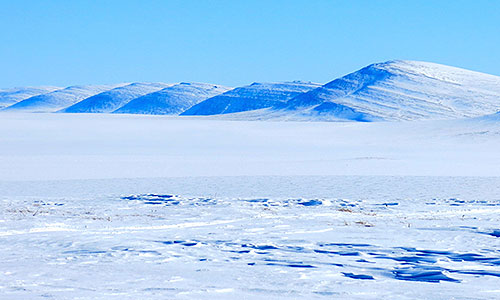
Far-north changes ponderedBy NED ROZELL
December 27, 2014
Here's some highlights from that and a few of thousands of science bites offered at the fall meeting of the American Geophysical Union. The meeting is held every December in San Francisco.
An Arctic landscape north of the Brooks Range. Many scientists talked about "Arctic amplification" of warming signals at the fall meeting of the American Geophysical Union in San Francisco.
The Beaufort Sea north of Alaska and western Canada has absorbed heat at a much greater rate than the Arctic Ocean as a whole. Sea ice melting in greater amounts in June, July and August allows the ocean to capture heat that would have otherwise bounced off ice. Scientists also found ocean temperatures near the surface are increasing one degree Fahrenheit per decade in the Chukchi Sea northwest of Alaska. That is one of the fastest rates measured on the planet. Recent short-term measurements are even more extreme. In Bering Strait west of Wales, the sea-surface temperature in August 2014 was more than 7 degrees warmer than the average for the last 30 years. This fall, UAF researcher Russell Hoscroft reported ocean temperatures in the Gulf of Alaska were warmer than any his team had measured in the previous 16 years. Since 2000, the Arctic Ocean has lost 541,000 square miles of what scientists call multi-year ice that has survived more than one summer and is more than nine feet thick. Newer, thinner ice has re-filled that space in winter. Because the younger ice will melt more quickly, "we're set up to lose a lot more ice now," said Walt Meier, a sea ice expert with NASA's Goddard Space Flight Center. At its peak coverage in September 2014, sea ice coverage on top of the globe was the sixth lowest since satellite observations became possible in 1979. Tied to a lack of sea ice and warmer temperatures, the weight of tundra vegetation increased by a whopping 20 percent during the last three decades worldwide north of the Arctic Circle, an area about three times as large as Europe. A revelation that surprised reporters: in 2014 the Greenland ice sheet showed no overall loss of ice mass. The island retained its bulk because of more snow accumulation in some areas and less melt in others, said Marco Tedesco of the National Science Foundation. This news came a day after scientists revealed they found lakes buried by snow on Greenland and an "aquifer" of free water beneath the ice lining the southeast and northwest coasts. All that water may be ripening Greenland for extreme melting. Some changes in the Arctic, such as Greenland ice remaining stable, were not dramatic in 2014, but scientists said the overall warming trend is unmistakable. Martin Jeffries, a sea-ice expert who worked at UAF's Geophysical Institute before taking his diplomatic skills to Washington, D.C. said he hopes people don't need yearly catastrophes to realize a long-term shift is underway. Jeffries, now Arctic Science Advisor for the Office of Naval Research, said he hopes one thing comes out of the U.S.'s two-year assignment in 2015 leading the Arctic Council, a political entity focusing on the Arctic. "Maybe we can raise awareness that we are an Arctic nation and the Arctic does matter to what people in Alaska call the Lower 48."
Rozell's employers have sent him to the fall meeting of the American Geophysical Union each year since 1999.
|
||
